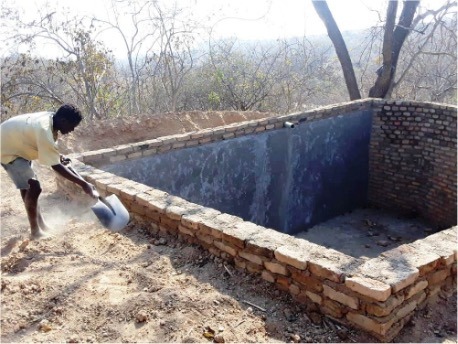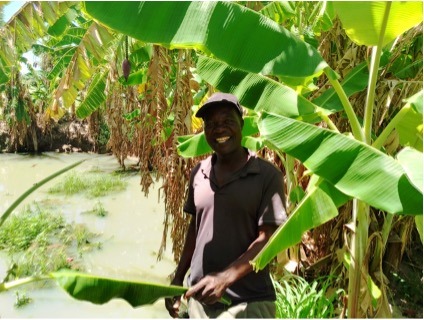Zimbabwe has dealt with recurring droughts and destructive floods for decades. But farmers there are adapting to the changing climate by implementing rainwater harvesting strategies. These same low-cost, scalable methods can be used to reduce the impact of droughts and floods by large- and small-scale farmers in the US.
Homegrown Harvesting Efforts
Since the devastating 1991-1992 drought, Zimbabwe, a landlocked country in Southern Africa, has been hit by several droughts—the most recent taking place in the 2021-2022 farming season. Experts have warned that by 2100, arid and semi-arid regions across Africa are expected to expand by five to eight percent. And in Zimbabwe, temperatures have risen by one degree Celsius over the past 40 years, while annual rainfall has decreased by 20 to 30 percent.
A 2019 study revealed that climate change had worsened the already precarious living conditions of many smallholder farmers who depend on rain-fed agriculture in Zimbabwe and surrounding countries. With limited technologies, rain-fed agriculture was the bastion of small-scale farming in the country. But now, more than 70 percent of the country’s population is in jeopardy as they rely solely on agriculture or rural economic activities.
Chitora, a sprawling small-scale farming community in Eastern Zimbabwe, was unable to sustain any meaningful rain-fed farming due to climate change. But a small thriving banana farm stands along the edge of a dusty road there. That’s because Blessing Zimunya, the farm’s owner and a local village leader, turned to rainwater harvesting in 2018 to access sustainable and reliable irrigation for his crops.
Alongside Zimbabwe’s increasingly longer droughts, rainy seasons are becoming shorter and, in most cases, are accompanied by extremely heavy rains. Most of that rainwater is lost through surface runoff as there was little infrastructure to catch that water for when it is most needed: during dry spells.
To combat this, Zimunya dug infield trenches alongside his crops to collect runoff, allowing the surrounding soil to retain moisture for longer periods of time and reducing reliance on rainwater. Besides minimizing water loss, the infield trenches reduce flooding by holding excess water and allowing that water to infiltrate the soil at a slower rate.
To further his water collection efforts, Zimunya built a 95,000-liter underground water tank to hold rainwater for irrigation. Soon, the tank will be connected to water pipes that will push water from the tank to Zimunya’s crop field. But he didn’t stop there; Zimunya also installed plastic tanks on the roof of his home to collect rainwater for non-drinking domestic uses.

In the neighboring Gutaurare Village, another farmer, Elliott Nzarayebani, has also had good results with rainwater harvesting. As Nzarayebani notes, rainwater harvesting completely changed his farming yields, which were dangerously low due to ongoing droughts. He built deep contours—locally called zvimbuyambuya—which act like trenches, capturing and reducing water runoff. He also dug large ponds to store rainwater for future uses. “I can now grow various crops all year round [due to having more available water]. Right now, I have yams, bananas, tomatoes, and leafy vegetables,” says Nzarayebani.

Rainwater Harvesting and Food Security
The largest food supplier in the US is California, which produces over 400 food commodities annually. Like Zimbabwe, the state is home to primarily small-scale farms that are bearing the brunt of climate change. California’s diminishing groundwater table has triggered a series of water restrictions “meant to avert water insecurity,” reports Zack Boyd for Stanford University’s By & the West. However, these restrictions are primarily geared to the state’s few large industrial farms and do not account for how small-scale farms will be impacted by even slight water restrictions. It is therefore crucial for small-scale farmers to implement low-cost and minimally invasive strategies, such as those being used in Zimbabwe.
Indeed, nonprofit organizations across Zimbabwe have already recognized the importance of climate change adaption and, in response, are spearheading grassroots rainwater harvesting efforts. Much of the country’s success in rainwater harvesting is due to the late Zephaniah Phiri Maseko, who was a rainwater harvesting pioneer based in the Zvishavane district. The district is one of the most resource poor areas in Southern Africa, but by studying rainfall patterns, Maseko devised irrigation practices that enabled subsistence farmers living in the district to sustainably produce abundant food through soil and water management strategies. Today, organizations, such as the Muonde Trust in Central Zimbabwe, are building on Maseko’s work by teaching a wide range of water-harvesting techniques to local communities.
In Southeastern Zimbabwe’s Zaka district, the nonprofit, Bopoma Villages, has been heading rainwater harvesting projects across 15 villages. The entity helps thousands of people by providing nutritious food, better health programming, and farming skills to the broader community.
“We teach simple strategies that consist largely of digging strategically located trenches and soak pits,” said Natalie Watson, managing director of Bopoma Villages. Soak pits, she explains, are porous walled, covered chambers that allow water to soak slowly into the ground. These pits help to temporarily raise the water table, which often gets very low during dry spells. Once the pit is full, the weight of that water loosens the soil beneath it to recharge the area’s groundwater, which is essential to water security and drought resilience. In warmer drought-stricken climates, like Zimbabwe’s, soak pits slow down water evaporation and nourish crops beyond the rainy season.
Towards Sustainable Use of Resources Organisation and PORET are two other organizations in the country’s eastern Chimanimani district that are working with communities to rehabilitate springs and wetlands. The organizations assist farmers in building small dams along gullies—a trench naturally worn into the earth by running water—to capture rainwater as it runs off the slopes.
One of the most experienced water conservation and management organizations in Zimbabwe is Dabane Trust, based in the Southwestern Bulawayo Province. The trust works with communities to map water catchments in their areas. (A water catchment zone, or “watershed,” is an area of land that channels rain runoff or snowmelt into a particular lake, stream, aquifer, wetland, or other body of water.)
The trust also helps farms and households repair soil erosion using catchment methods such as bunds and gabions. Bunds are semicircular shallow depressions that are dug into slopes. The ends of the bund face upward to catch and slow down runoff during heavy rains. Gabions are low, leaky barriers placed perpendicular to the flow of water. Vertical poles are driven 0.5 to 1 millimeter into a flow of water and held together by interwoven branches. By slowing down water flow, gabions minimize erosion and allow the soil to retain organic matter. Both catchment methods are effective in easing downstream flooding.
Another goal of the Dabane Trust is to provide holistic farming support. Most farmers seeking support want to practice conservation farming—a regenerative way of farming that prevents further damage to arable land as it promotes minimum soil disturbance. Conservation farming also focuses on the value of crop diversification, which advances plant biodiversity. In addition, the trust helps farmers with livestock grazing management and agroforestry—a land management method that involves planting trees alongside crops—and stream bank and wetland protection. Conversation farming, grazing management, and agroforestry are all mitigation and adaptation strategies that help farmers increase their ability to thrive despite the impacts of climate change.
Beyond Zimbabwe
New water conservation practices, including mulching and dead-level contours, are popping up in other regions across the African continent. Mulching—or covering the soil with organic matter, such as leaves and wood chips—reduces soil evaporation, controls soil temperature, and increases healthy soil microbial activity. Similar to channels but less deep, dead-level contours are trenches dug into flat land. Such contours reduce water loss from the soil through evaporation as water can sit inside them for up to five weeks. With these methods, smallholder farmers can irrigate their land, gardens, and even orchards between rains, producing enough food for their families.
Farmer Nzarayebani summed it up when he said: “With proper rainwater harvesting practices, farmers will never go wrong.”
Meanwhile, in 2019, UN Environment Program and the UN Educational, Scientific and Cultural Organization launched a new smart phone app that calculates the amount of rainwater that can be harvested from the roofs of houses. The app, which uses meteorological data collected from weather stations across Africa, can be used anywhere on the continent and has been successfully deployed in parts of Kenya and Algeria. The data is specific to locations closest to weather stations, which the app presents as the nearest city, UN Environment said.
“This app is practical for individuals as well as communities, local governments, and other actors who are planning to install rainwater harvesting systems in Africa,” Juliette Biao, director of the UN Environment’s Africa Office, was quoted as saying. “The app is a concrete example of how science and innovation can be packaged to solve day-to-day needs of households in Africa.”
Recognizing the power of rainwater harvesting on their own properties, a few people affected by atmospheric river storms in California bought cisterns and industrial barrels to harvest rainwater from their roofs, The Guardian reports. Meanwhile, according to Arizona Public Media, Tucson, AZ, plans to implement rainwater harvesting in its forthcoming 80-year water master plan.
Small-scale farming in the US is slowly starting to adapt as conservation farming has become a growing practice across the country. In 2018, Congress passed the Agriculture Improvement Act to broaden programs for farmers and ranchers looking to improve water quality and local wildlife habitat populations. As individuals and localities in the US make such changes, they can learn a lot from communities in countries like Zimbabwe, which are already effectively adopting these techniques.

0 Commentaires